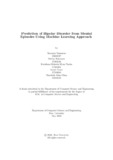Prediction of bipolar disorder from mental episodes using machine learning approach
Date
2022-06-05Publisher
Brac UniversityAuthor
Tasmeem, SumaiyaRahaman, Motiur
Piasha, Karishma Meherin Khan
Yasar, Samin
Dina, Murshida Akter
Metadata
Show full item recordAbstract
A precious gift to mankind is the ability to express their emotions or feelings and also to realize. Sometimes, an omnipresent sustained feeling or emotion can dominate a person’s behavior and affect his perception which can also be defined as mood. There can be illnesses of mental health like any other diseases. A bipolar disorder is one of them which is also known as manic-depressive disorder where people feel overly happy and energized sometimes and feel very sad, hopeless and unmotivated other times. It can be thought of the highs and lows as two poles of mood and this is why it is named as bipolar disorder. There are many factors which work as the main reason for this disorder such as chemical imbalance in the brain, genetic issues, periods of high stress, over uses of drugs or alcohol and many others. Now-a-days cases of bipolar disorder are increasing at an alarming rate. If it can be predicted at the primary stage, the number of cases can be reduced. Technology plays a vital role in the health sector as it is used to lessen the complication and fasten the treatment. The aim of this research is to apply different Machine Learning algorithms to symptoms-based data of patients in order to help to build a model for prediction. This model will not only focus on detecting the disease but also will provide the primary treatment to the patient. We will develop a diagnostic algorithm based on an online questionnaire. Then, a trained dataset and machine learning algorithms will be used to recognize individual bipolar disorder patients. After that, to train and validate our diagnostic model we will use an extreme gradient boosting and cross validation. Another algorithm will be used which is called Light Gradient Boosting Machine Algorithm for ensuring the best result to fulfil our main goal. Last but not the least, some random forest algorithms will be used for detecting and differentiating between the types of BD accurately so that the cases of mistreatment can be brought down.

